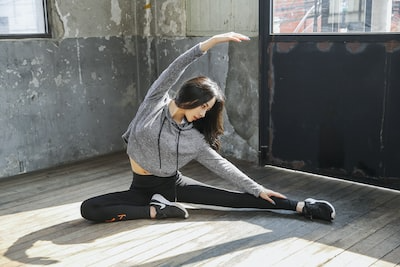When engaging in physical activity, understanding how to exercise safely to avoid injury is crucial for beginners and seasoned athletes. Taking the necessary precautions and following expert guidelines can significantly reduce your risk of sustaining injuries while pursuing your fitness goals.
To ensure a safe and effective workout, this blog post will provide strategies for warming up through dynamic stretching exercises, cardiovascular activities, and gradual progression in exercise intensity. We’ll discuss the importance of warming up through dynamic stretching exercises and cardiovascular activities like jumping jacks or jogging in place. Additionally, we’ll delve into gradual progression in exercise intensity by monitoring heart rate zones and providing examples of plans suitable for different fitness levels.
Furthermore, our discussion on proper form and technique will highlight common mistakes leading to poor execution and tips on learning from qualified trainers. Pre-workout nutrition guidelines are essential too; thus, we’ll cover ideal macronutrient ratios for pre-workout meals along with sample meal ideas.

Maintaining optimal hydration during exercise is vital for avoiding injuries; therefore, we’ll examine signs indicating dehydration and electrolyte replacement strategies. Choosing appropriate workout attire also plays a significant role in injury prevention – expect insights on moisture-wicking synthetic fiber socks selection and footwear recommendations based on exercise type.
Last but not least, walking is an excellent low-impact option for those seeking to minimize risks while reaping the health benefits of regular physical activity. In this regard, we’ll provide tips to make walking more enjoyable and effective so that you can confidently embark upon your journey towards improved fitness, knowing how to exercise safely to avoid injury.
Table of Contents:
- Importance of Warming Up
- Gradual Progression in Exercise Intensity
- Proper Form and Technique
- Pre-Workout Nutrition
- Hydration Practices During Exercise
- Appropriate Attire for Exercise
- Walking: A Safe Exercise Option
- FAQs about How to Exercise Safely to Avoid Injury
- Conclusion
Importance of Warming Up
Warming up correctly is crucial for safe exercising. Take 5-10 mins to do a dynamic warm-up to get the blood pumping and help avoid potential injuries.
Active Warm-Up Exercises for All Fitness Levels
- Dynamic stretches like leg swings, arm circles, and hip rotations improve flexibility and heart rate.
- Moderate-intensity cardio exercises such as brisk walking or light jogging can be customized to individual abilities while raising body temperature and circulation effectively.
- Bodyweight exercises like squats, lunges, and push-ups (modified if necessary) activate major muscle groups without requiring equipment.
Benefits of Increased Blood Flow During Exercise
A proper warm-up offers numerous benefits related to increased blood flow during exercise:
- Better oxygen delivery: Improved circulation ensures that your muscles receive adequate oxygen throughout physical activity.
- Faster removal of waste products: Enhanced blood flow allows faster elimination of metabolic byproducts like lactic acid from working muscles, preventing fatigue and soreness after workouts.
- Promotes joint health: An active warm-up increases synovial fluid production in joints, acting as a lubricant and shock absorber during movement, helping you avoid injuries associated with stiff joints or overuse.
By incorporating an active warm-up into your exercise routine, you can help ensure that your body is adequately prepared for more strenuous physical activity while minimizing the risk of injury. Remember to choose exercises suitable for your fitness level and prioritize proper form when performing any movement. Don’t let avoiding injuries keep you from physical activity.
Gradual Progression in Exercise Intensity
Starting slow and gradually increasing intensity is key to avoiding injuries when engaging in physical activity. Here are some tips on how to start slow with different types of workouts and how to monitor progress effectively.

Tips on How to Start Slow with Different Types of Workouts
- Aerobic exercises: Begin with low-impact activities like walking, swimming, or cycling at a comfortable pace for short durations (10-15 minutes). Gradually increase duration and speed as you build endurance.
- Strength training: Start using light weights or resistance bands while focusing on proper form. Increase weight gradually as you become stronger, aiming for two-three sets of 8-12 repetitions per exercise.
- Flexibility exercises: Incorporate gentle stretching routines into your daily schedule. Hold each stretch for about 20 seconds without bouncing or forcing the movement; repeat two-four times per muscle group.
Monitoring Progress and Knowing When to Increase Intensity
To avoid injury while progressing in your fitness journey, listening to your body and tracking measurable improvements such as increased strength, endurance levels, and flexibility gains is crucial. Here are some indicators that can help determine when it’s time for an upgrade in workout intensity:
- Your heart rate returns quickly within normal range after physical activity – indicating improved cardiovascular fitness.
- You can perform more repetitions or lift heavier weights without compromising form – a sign of increased strength and muscle development.
- Your flexibility has improved, allowing you to move through a more excellent range of motion during stretches and exercises.
Gradually increasing your activity level is the safest way to gain the advantages of physical exercise without risking harm. So, start slow and steady, and watch yourself progress over time.
To avoid injury, it’s important to start slow and gradually increase intensity when exercising. This can be achieved by beginning with low-impact activities for short durations, using light weights or resistance bands while focusing on proper form, and incorporating gentle stretching routines into your daily schedule. Monitoring progress through measurable improvements such as increased strength, endurance levels, and flexibility gains is also crucial in determining when to upgrade workout intensity.
Proper Form and Technique
Correct form is crucial to avoid injuries during exercise. Take the time to learn proper techniques when starting a new workout or playing sports. This ensures that you don’t strain your muscles and joints unnecessarily. By avoiding injuries, you can maintain consistency in your physical activity routine and achieve better results.
Common Mistakes in Form for Popular Exercises
- Squats: Leaning forward too much while squatting puts excessive stress on your knees. To avoid this, keep your chest up and push your hips back as you lower yourself.
- Lunges: Letting your front knee extend past your toes is a common mistake with lunges. Keep your front knee above your ankle throughout the movement to ensure proper alignment.
- Push-ups: Incorrect hand placement can cause shoulder pain during push-ups. Position your hands slightly wider than shoulder-width apart for optimal range of motion without discomfort.
Resources for Learning Proper Technique
Educate yourself about proper form before starting any new fitness program or sport to ensure safe workouts. Here are some resources to help you learn the correct techniques:
- Certified personal trainers: Working with a knowledgeable trainer provides personalized guidance tailored to improve your weaknesses while ensuring safety throughout each session. National Academy of Sports Medicine
- Fitness classes: Participating in group classes led by experienced instructors offers an opportunity to practice good form under expert supervision. American Council on Exercise
- Online tutorials: Many reputable fitness websites and YouTube channels offer instructional videos demonstrating proper exercise techniques. Choose sources with certified professionals providing guidance. Bodybuilding.com, Fitness Blender
Pre-Workout Nutrition
Eating a light, balanced meal two hours before training gives your body the necessary energy without causing discomfort during exercise. A well-fueled body can perform better while reducing the risk of injuries due to fatigue or lack of nutrients.
Examples of Balanced Pre-Workout Meals
- Energy bowls: Combine fruits, nuts, seeds, and yogurt for a nutrient-dense snack that’s easy to digest.
- Smoothies: Blend fruits, vegetables, protein powder, or Greek yogurt for an easily digestible pre-workout boost.
- Portable snacks: Opt for whole-grain crackers with hummus or almond butter on apple slices as convenient options for on-the-go.
- Oatmeal: Top cooked oats with fresh fruit and a drizzle of honey for sustained energy throughout your workout.
The Role Nutrition Plays in Injury Prevention
Nutrition is crucial when it comes to avoiding injuries during physical activity. Consuming adequate amounts of essential nutrients like carbohydrates, proteins, fats, vitamins, and minerals ensures that our muscles are prepared to handle the stress during exercise. Proper nutrition helps maintain muscle strength and flexibility while promoting faster recovery after workouts by repairing damaged tissues more efficiently.
In addition to providing fuel for your workout sessions, proper hydration is equally important in preventing injuries. Consuming enough water helps regulate body temperature, lubricate joints, and transport nutrients to your muscles. Dehydration can lead to muscle cramps, dizziness, and even more severe issues like heatstroke or hyponatremia (low blood sodium levels). Therefore, ensuring sufficient hydration before engaging in physical activity is essential for optimal safety and performance.
Before physical activity, proper nourishment and hydration can help reduce the likelihood of injury and optimize performance.
Hydration Practices During Exercise
Proper hydration is critical to avoiding injuries during physical activity. Consume at least 16 ounces (500ml) of liquid before and after physical activity for adequate hydration. Here are some signs of dehydration to watch out for during exercise:
Signs of Dehydration During Workouts
- Fatigue: Feeling tired or weak during your workout could mean not being hydrated enough.
- Dizziness: Feeling lightheaded or dizzy, especially when standing up quickly, could indicate dehydration.
- Rapid Heart Rate: If your heart rate is higher than usual without increased exercise intensity, you may need more fluids.
- Dry Mouth and Thirst: Feeling thirsty with a dry mouth indicates that your body needs more fluids.
Ensure you drink water consistently throughout the day and consume enough fluids based on your needs to avoid these symptoms.
Electrolyte Replacement Options Post-Exercise
Replenishing electrolytes lost through sweat is crucial for maintaining proper hydration levels. Electrolytes are minerals that help regulate fluid balance within our bodies. Here are some options for replacing electrolytes after exercising:
- Sports drinks contain electrolytes and carbohydrates to help refuel your body.
- Fruits like bananas, oranges, and watermelon are rich in potassium and can naturally replenish lost electrolytes.
- Coconut water is another excellent source of potassium and other essential minerals for hydration.
- Electrolyte tablets or powders can be added to water for a convenient post-workout drink option.
Proper hydration practices during exercise will help you avoid injuries and improve overall performance. Listen to your body’s signals and stay hydrated.
Appropriate Attire for Exercise
Wearing the right clothes for physical activity significantly reduces the risk of injury while exercising. Opt for close-fitting yet comfortable clothing to avoid accidents caused by loose garments catching onto equipment or other obstacles. Let’s discuss how to choose suitable gear, including footwear and moisture-wicking socks, and how different types of exercise require specific attire.
Choosing Suitable Gear: Footwear and Moisture-Wicking Socks
Proper footwear is crucial in avoiding injuries during workouts. Shoes should provide ample support, cushioning, and stability tailored to the specific exercise you’re engaging in. For example, running shoes are designed with extra cushioning to absorb impact while walking shoes offer more arch support. Additionally, wearing moisture-wicking socks can help prevent blisters by keeping your feet dry throughout your workout.
Different Types of Exercise Require Specific Attire
- Aerobic exercises: Wear lightweight clothes made from breathable materials like polyester or nylon blends that wick away sweat effectively.
- Strength training: Choose form-fitting clothing that doesn’t restrict movement but provides adequate coverage during weightlifting sessions; avoid baggy clothes that may get caught on equipment.
- Yoga/Pilates: Opt for stretchy fabrics such as spandex or cotton blends that allow a full range of motion without slipping out of place during poses.
- Swimming: Invest in a well-fitting swimsuit that stays put during laps and water-based exercises; avoid loose or baggy swimwear, which may cause drag and impede movement.
Selecting the appropriate attire for your chosen exercise form helps prevent injuries and enhances performance. Investing in suitable gear will make you better equipped to enjoy your workouts safely and effectively.
Walking: A Safe Exercise Option
Walking is a safe way to engage in physical activity without putting too much strain on your body. Walking is ideal for those just starting or returning from injury due to its low-impact nature and availability almost anywhere.
Benefits of Walking
- Improves cardiovascular health: Walking helps lower blood pressure, improve circulation, and reduce the risk of heart disease.
- Aids weight management: Regular walks can help you maintain a healthy weight by burning calories and increasing your metabolism.
- Boosts mental well-being: Walking reduces stress, increases mood, and improves overall mental health.
- Protects joints: Walking is a low-impact exercise that puts less stress on your joints than high-impact activities like running or jumping.
Tips for Incorporating Walking into Your Fitness Routine
- Set achievable goals: Start with short distances or durations and gradually increase them over time while monitoring how your body feels during these sessions.
- Schedule regular walks: Plan specific times each day or week when you will dedicate yourself to this activity. Consistency is key.
- Choose enjoyable routes: Pick walking paths that are scenic, safe, and have comfortable terrain to make your walks more enjoyable and motivating.
- Vary the intensity: Incorporate brisk walking or interval training into your routine to challenge yourself and avoid boredom. This can also help improve cardiovascular fitness faster.
Avoiding injuries while staying active is crucial for long-term health and well-being. Incorporating a walk into your everyday life can effectively promote health while avoiding potential harm.
FAQs on How to Exercise Safely to Avoid Injury
How can exercise prevent injury?
Regular exercise strengthens muscles, increases flexibility, and improves balance, reducing the risk of injuries. Engaging in activities like stretching and resistance training helps maintain joint stability and prevents muscle imbalances that could lead to strains or sprains. Research also shows that consistent physical activity enhances bone density, lowering the chances of fractures.
Four ways to prevent injuries during physical activity:
- Warm-up: Begin with dynamic stretches to increase blood flow and prepare your body for movement.
- Maintain proper form: Ensure correct technique while exercising to avoid unnecessary stress on joints and muscles.
- Incorporate rest days: Allow recovery between workouts to prevent overuse injuries.
- Cross-train: Vary your workout routine by incorporating different types of exercises, reducing repetitive strain on specific muscle groups.
Five ways to avoid injury:
- Prioritize warming up before each workout session.
- Focusing on gradual progression in intensity.
- Educate yourself about proper form and technique.
- Maintain a balanced diet with good hydration practices.
- Select appropriate attire, including footwear, for specific activities.
Five exercise safety tips:
- Create a well-rounded fitness plan, including strength training, cardio, and flexibility exercises.
- Listen to your body’s signals and adjust workouts accordingly.
- Choose a safe environment for exercising, free of hazards.
- Seek guidance from fitness professionals when needed.
- Incorporate rest days to allow muscles time to recover and rebuild.
Conclusion
Exercise without injury: Tips for staying safe
Exercising is excellent for your health, but it’s essential to do it safely to avoid getting hurt.
Start with a proper warm-up with dynamic stretching exercises to prepare your muscles for action.
Gradually increase the intensity of your workout to avoid overexertion and injury.
Remember to maintain proper form and technique during your exercises.
Stay hydrated and fuel your body with pre-workout nutrition to keep your energy levels up.
Wear appropriate workout attire, including moisture-wicking socks and suitable footwear for your exercise type.
Walking is a low-impact option that provides numerous health benefits when done regularly.
For more information on safe exercising, check out these credible sources:







Sorry, comments are closed for this post.